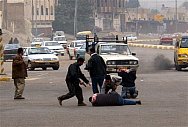Assassination Photo Raises MORE Questions


The bloggers smell a rat with AP's photo of the assassination of Iraqi election workers. Belmont Club has a post with multiple comments (here) that support the argument that AP's photographer may well have had advance warning, just as Eddie Adams did when he was invited by ARVN Gen. Nguyen Ngoc Loan to the summary execution of Vietcong commander Bay Lop on a Saigon street.
The bloggers' main argument is that the photo appears to have been taken by a photographer who was standing upright, despite reports that grenades and rifle shots preceded the execution. They are right on the perspective; a prone photographer (and that's the position I'd be in with bullets and shrapnel flying!) would have produced a very different photograph.
But I'm not ready to buy the Belmont argument. Maybe the assassins aren't connoisseurs of the finer points of photojournalism, but look at the two photos - which is the more dramatic? If the assassins didn't seem to care if anyone saw their faces, and if they wanted to really scare off election workers, why did they position the photographer so far away? If the photograph was indeed staged, they could have done a much better job of setting it up.
In any case, I think the larger point -- and a point Belmont hasn't made yet -- is what happened to the photo after it hit the AP photo editor's desk. Zooming in on the photo (digitally or by cropping) would have increased its impact. But he ran a shot that is uncharacteristiclly long. And photojournalists don't shoot just one shot of something like this -- is this the best he could do? Was there really not a single frame that showed the fear of the victims more? Probably.
They almost certainly could have made the photo much more impactful, but they chose not to. I think it's evident that the photo editors at AP did all they could to relate a story of chaos in Iraq without going so far as printing something as impactful as Eddie Adams' photo.




<< Home